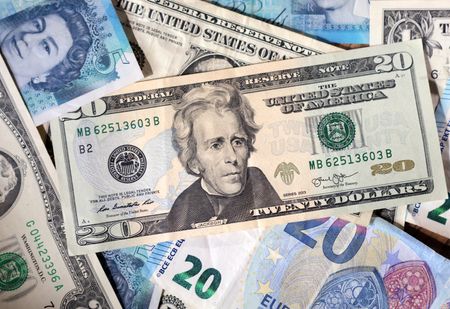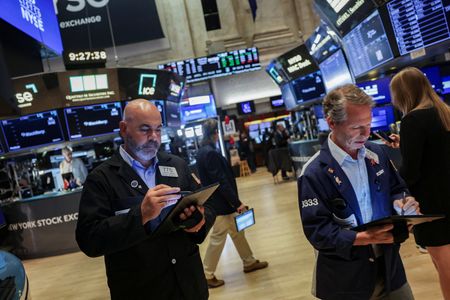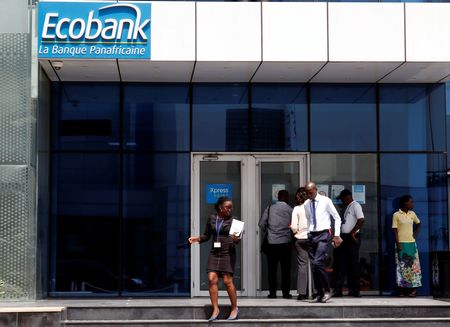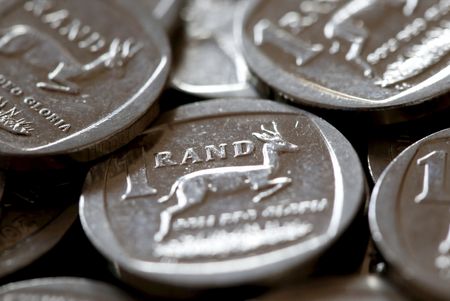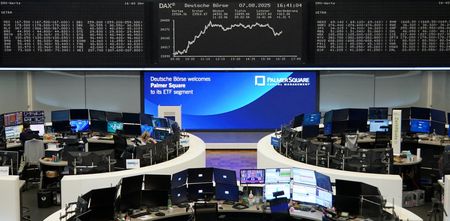By Samuel Indyk and Gregor Stuart Hunter
LONDON (Reuters) -The U.S. dollar was little changed on Monday before Tuesday’s deadline for Washington and Beijing to strike a tariff deal and a key U.S. inflation report that could help determine whether the Federal Reserve lowers borrowing costs next month.
The dollar index was down less than 0.1% to 98.164 after last week’s 0.4% fall. Against the yen, the U.S. currency traded at 147.39, down 0.2%. Japanese markets were closed on Monday for the Mountain Day holiday.
The euro was up less than 0.1% at $1.1652, while sterling was flat at $1.3462.
The dollar remains on the back foot as investors recently adjusted their expectations for interest rate cuts from the Fed after soft U.S. jobs and manufacturing figures.
Fed officials have sounded increasingly uneasy about the labour market, signalling their openness to a rate cut as soon as September.
Cooling inflation could cement bets for a cut next month but if signs emerge that U.S. President Donald Trump’s tariffs are fuelling price rises it might keep the Fed on hold for now.
“It’s important to note ahead of tomorrow’s data that the bar for a hawkish surprise is higher,” said Francesco Pesole, FX strategist at ING.
Pesole added that a 0.3% monthly rise in core CPI would give the Fed room to lower interest rates, given the deterioration in the labour market.
Economists polled by Reuters expect core CPI to have risen 0.3% in July, pushing the annual rate higher to 3%.
Money market traders are pricing in around a 90% chance of a rate cut next month, while 58 basis points of easing are priced in by year-end, implying two quarter-point cuts and around a one-in-three chance of a third.
Personnel moves at the Fed have also weighed on the dollar recently as Trump prepares to install rate-setters that support his dovish views on monetary policy, including a new chair for when Jerome Powell’s term ends in May.
Trade talks were also in focus as Trump’s August 12 deadline for a deal between the U.S. and China neared, particularly on chip policy. “The market has fully priced in the idea that we’re going to get an extension,” said Chris Weston, head of research at Pepperstone Group Ltd in Melbourne, adding that another 90-day truce was most likely. With the U.S. and China seeking to close a deal averting triple-digit goods tariffs, a U.S. official told Reuters that chip makers Nvidia and AMD had agreed to allocate 15% of China sales revenues to the U.S. government, aiming to secure export licences for semiconductors. “I don’t know if that’s going to be a good thing or a bad thing, but if it puts closure on the matter, it’s not a bad outcome,” Weston said.
“If this is Trump saying 15% and we’ll call it a day, that may not be too bad.”
The offshore yuan fluctuated between gains and losses, trading at 7.1854 to the dollar, after weekend data showed China’s producer prices fell more than expected in July, while consumer prices were unchanged. The Australian dollar fetched $0.6520, trading flat ahead of a rate decision by the central bank on Tuesday, in which it is widely expected to cut rates by 25 basis points to 3.60%, after second-quarter inflation came in weaker than expected and the jobless rate hit a 3-1/2-year high.
Cryptocurrencies jumped, with bitcoin rising as high as $122,308, not far from its July 14 record of $123,153.22, after Trump’s executive order on Thursday freed up cryptocurrency holdings in U.S. retirement accounts.
Ether rose as high as $4,346, its highest since December 2021.
(Reporting by Samuel Indyk and Gregor Stuart Hunter; Editing by Clarence Fernandez and Mark Potter)

